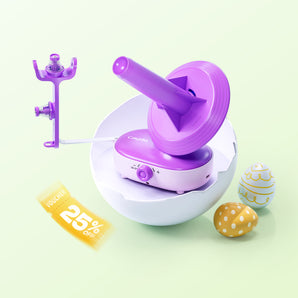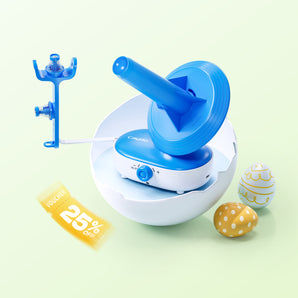Finding the best yarn ball winders can improve your knitting and crocheting experience by transforming loose hanks into neat, usable cakes.
These essential tools save countless hours and eliminate the frustration of tangled yarn interrupting your creative flow. From budget-friendly options there's a perfect winder for every crafter's needs.
Ready to transform your crafting experience? Read on to discover which yarn ball winder deserves a place in your crafting toolkit.
What Is A Yarn Ball Winder And Why You Need One
A yarn ball winder is a handy tool that transforms loose skeins of yarn into neat, compact cakes that are easy to work with. This clever device helps you organize your yarn stash while making your knitting and crocheting projects more enjoyable.
Benefits Of Using A Yarn Ball Winder For Knitting And Crocheting
Yarn ball winders create center-pull cakes, allowing you to pull yarn from the middle without the ball rolling around as you work. This makes your crafting experience much smoother!
Having a ball winder lets you divide one skein into two smaller skeins when needed, saving you money on extra yarn purchases.
These devices help you spot problems before you start your project. You can inspect your yarn for knots or weak spots while winding, fixing issues before they interrupt your creative flow.
The flat-bottomed cakes that winders create can be stacked neatly, making storage much easier than with traditional balls. Your yarn collection will take up less space and look more organized!
How Yarn Ball Winders Save Time And Prevent Tangling
Winding yarn by hand is time-consuming and can strain your wrists. A yarn ball winder does the job in minutes, letting you focus on your actual projects instead of preparation.
The most frustrating part of knitting or crocheting is dealing with tangled yarn. Ball winders create cakes with a uniform flow that prevents annoying knots and tangles during your project.
Many winders have a compact design, making them easy to store when not in use. You can quickly set up your winder when needed and put it away afterward.
Working with pre-wound cakes means no more chasing balls of yarn across the floor! The center-pull design keeps your yarn in place as you work, making crafting more enjoyable and less stressful.
Types Of Yarn Ball Winders Compared
Choosing the right yarn ball winder can make a huge difference in your crafting experience. These handy tools save time and create neat, center-pull cakes that are easier to work with than loose skeins.
Manual vs. Electric Yarn Winders: Pros And Cons
Manual Yarn Winders
- Cost: Usually $20-$60 for basic models, up to $200 for premium options
- Control: You control the speed with a hand crank
- Portability: Lightweight and can be used anywhere
- Maintenance: Fewer parts that can break down
Manual winders are popular among hobbyists. This specific model can handle up to 10 ounces of yarn, making it suitable for most projects.
Electric Yarn Winders
- Speed: Much faster than manual options
- Effort: No hand cranking needed - great for arthritis sufferers
- Price: More expensive ($100-$300+)
- Noise level: Can be noisy during operation
Electric winders are perfect if you wind lots of yarn or have physical limitations. They do require power outlets, so you'll have less flexibility in where you use them.
Key Features To Look For In Quality Yarn Winders
Weight Capacity: Check how many ounces the winder can handle. Basic models often max out at 4 ounces, while heavier duty options can manage 10+ ounces.
Clamp Quality: A sturdy clamp that attaches securely to your table is essential. Rubber-coated clamps protect furniture surfaces.
Gearing System: Metal gears last longer than plastic ones. Pay attention to this if you'll be using your winder frequently.
Yarn Guide: A good yarn guide helps prevent tangles and ensures even winding. Some premium models include adjustable tension control.
Companion Tools: Consider if you need a yarn swift too. Swifts hold your yarn hanks while the winder does its job, preventing tangles.
The Best Yarn Ball Winders of 2025
Looking for the perfect yarn ball winder can transform your knitting and crocheting experience. The latest models offer improved efficiency and reliability that will save you time and reduce hand strain.
Electric Yarn Cake Winder M1
The Caydo M1 Electric Yarn Winder offers efficient automatic winding, eliminating hand fatigue while transforming loose yarn into compact yarn cakes in minutes. It saves time and helps organize your yarn collection effectively.
You'll appreciate the tight yarn cakes created by the dual spring system that provides adequate tension, reducing yarn vibration and knotting during the winding process. This ensures smooth operation and beautiful, compact yarn cakes without manual pulling.
The M1 features:
- Stepless speed control for different yarn types
- Large 7oz capacity in a compact body
- Durable ABS+POM construction
- Quiet operation that won't disturb others
The yarn cakes produced allow for smooth pulling from either the center or outside, reducing the risk of knots and increasing your knitting efficiency. They're also space-saving and help prevent tangling during use while maintaining stable tension.
Perfect for both beginners and experienced crafters, this winder makes an excellent gift for any yarn enthusiast in your life!
Electric Yarn Ball Winder M1 Pro: Premium Option For Serious Crafters

If you crochet or knit daily, the M1 Pro Electric Yarn Winder offers serious upgrades as the largest yarn ball maker on the market. Say goodbye to boring and inefficient hand-operated winders with this premium model that brings an upgraded winding experience.
The Pro model includes advanced features not found on standard winders:
- 3rd-Gen stepless speed with ergonomic control knob
- Dual-spring design for stable, strong tension
- 10oz large capacity (more than twice compared to others)
- High-performance motor for all yarn types
You'll notice the difference in how the dual-spring design minimizes yarn vibration, ensuring tighter, more stable winding that creates more compact balls while preventing tangles. This delivers a remarkably smooth winding experience.
The M1 Pro is easy to install and use, featuring anti-slip silicone to improve stability. Made of high-quality ABS material, it ensures a longer lifespan and enhanced durability. The exquisite packaging makes it the perfect present for yourself or any yarn collection lover in your life.
How To Choose The Best Yarn Ball Winder For Your Needs
Selecting the right yarn ball winder can make a huge difference in your crafting experience. The perfect winder will save you time, protect your yarn, and make your projects more enjoyable.
Yarn Capacity: Finding The Right Size For Your Projects
When shopping for a yarn ball winder, one of the first things to consider is how much yarn it can handle. Most standard winders can wind balls up to 4 ounces, which works great for smaller projects and lighter yarns.
If you work with bulky yarns or larger projects, you might need a heavy-duty option. Think about your typical projects:
- Small projects (socks, hats): Standard 4oz winder
- Medium projects (scarves, shawls): 4-6oz capacity
- Large projects (blankets, sweaters): 8-10oz capacity
Don't forget to consider storage space too! Larger winders take up more room in your craft area.
Durability Factors: Materials And Construction Quality
Your yarn winder should last for years, so check what it's made from before buying. Metal cranks will outlast plastic ones every time.
The clamp is another key part to inspect. You need one that grips firmly to your table without wobbling or coming loose.
Some winders have rubber-coated clamps that protect your furniture while providing better grip.
Look at these parts carefully:
- Gears (metal lasts longer than plastic)
- Base (heavier bases provide more stability)
- Yarn guide (should be smooth to prevent snags)
Speed Control And Tension Management Features
Your winder should create neat, center-pull balls with consistent tension. Too tight, and your yarn stretches out. Too loose, and your ball falls apart.
A good yarn guide helps manage tension, especially with slippery yarns.
Using a yarn swift with your winder makes the process much smoother. Swifts hold your hanks while unwinding, preventing tangles and maintaining even tension.
Cranking speed matters too! Look for:
- Smooth turning mechanism
- Comfortable handle grip
- Gear ratio that matches your winding style
Some winders let you control speed better than others. You'll want this feature if you work with delicate or expensive yarns that need gentle handling.
Final Verdict: Choosing The Right Yarn Ball Winder
Caydo's yarn ball winder stands out in the market, combining durability, ease of use, and efficiency to enhance your crafting experience. Its ability to handle large amounts of yarn while creating stable center-pull cakes makes it a favorite among knitters and crocheters who value quality and convenience in their tools.
Remember that the perfect winder for you depends on your specific needs, budget, and the types of yarn you typically use. Consider factors like capacity, construction materials, and whether you prefer manual or electric operation. Whichever model you choose, a quality yarn ball winder is an investment that will serve your crafting passion for years to come.
Ready to take your crafting to the next level? Complete your crafting toolkit with Caydo's innovative i-Cord knitting machine and our comprehensive crochet and knitting sets! These perfectly paired companions to your yarn ball winder will streamline your projects and unlock new creative possibilities.
Frequently Asked Questions on the Best Yarn Ball Winders
What is the capacity of a yarn winder?
The capacity of yarn winders varies by model. Standard manual winders typically handle 3.5-10 ounces (100-280g) of yarn.
Premium models may accommodate up to 16 ounces. When selecting a winder, consider your typical project size and yarn weight to ensure adequate capacity for your needs.
Do I need a yarn winder for tufting?
While not essential, a yarn winder greatly improves tufting projects by creating organized cakes that feed smoothly through your tufting gun without tangling. It also allows you to prepare multiple colors in advance for efficient switching during your project. Many experienced tufters consider a quality yarn winder an invaluable tool, especially for larger or multi-colored projects.
How do you calculate yarn requirements?
Calculating yarn requirements depends on project size, yarn weight, and tufting density. For tufting, acrylic yarn typically requires about 1kg per square meter, while wool needs approximately 2.5kg per square meter for a 12mm pile height.
For precise calculations, measure your project dimensions and use a tufting calculator tool to input your design specifications. Always purchase slightly more yarn than calculated to avoid running short mid-project.
How do you increase yarn winder capacity?
Several methods can increase your yarn winder's capacity. Try using a larger cardboard tube as the base for winding, providing more surface area. Alternatively, pair your winder with a swift or yarn feeder arm to maintain tension while winding larger amounts.
But for larger projects, consider winding multiple cakes in advance—the efficient electric motor completes each cake in minutes, saving significant time compared to manual winding.








![[Must-have] Knitting Yarn and Wire Set - Caydo](http://www.caydo.com/cdn/shop/files/3_4c349a4b-7e4d-4fa8-b6df-6561cf08410c.jpg?v=1731059827&width=298)
![[Must-have] Knitting Yarn and Wire Set - Caydo](http://www.caydo.com/cdn/shop/files/1_c1a8ec5f-79f5-4c02-b655-aaba689678cf.jpg?v=1731060862&width=298)











